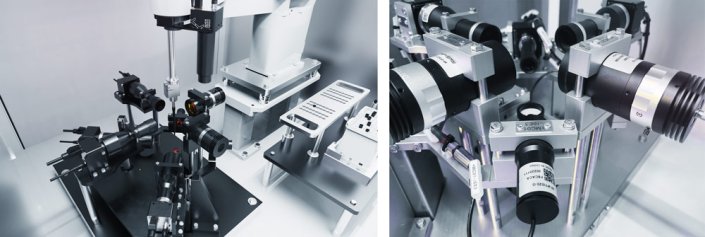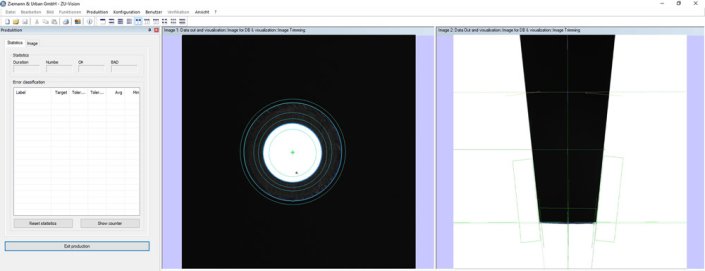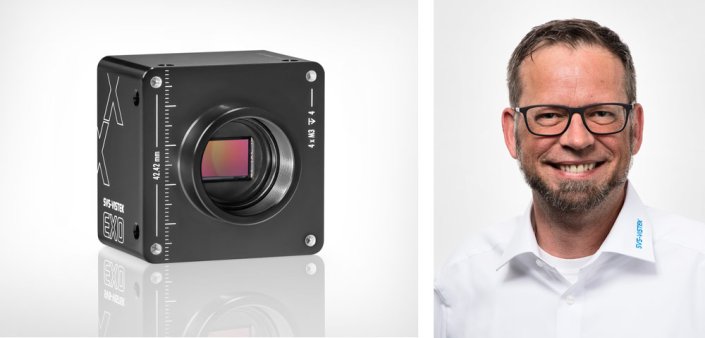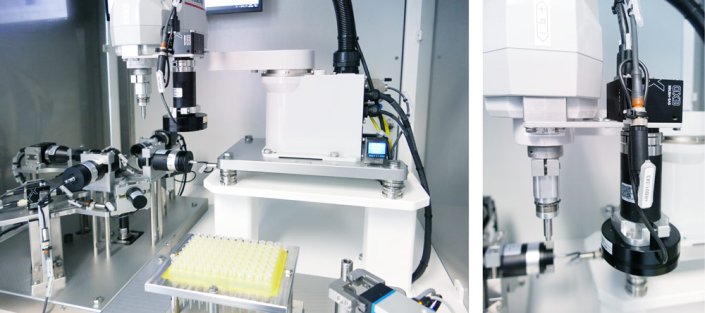Case Study Automated pipette tip inspection
Do you have a similar requirement or questions?
Our experts will be happy to answer your questions and help you find the optimum system for you. ContactAutomated inspection stations from Ziemann & Urban, equipped with industrial cameras from SVS-Vistek and other image processing components, enable pipette tip manufacturers to inspect pipette tips with high precision and at the same time economically.
They are used in medical technology and laboratories around the world to dispense precisely measured quantities of liquid for subsequent analysis: Pipettes. Their tips have to meet very strict quality requirements in order to do their job as intended, knows Markus Urban, one of the Managing Directors of Ziemann & Urban, a company based in Moosinning, Bavaria, Germany: "Even slight burrs in the injection mold or other defects on a pipette tip can mean that liquids picked up in the laboratory do not end up where they are supposed to, or that the liquid quantities are incorrect. The result can be incorrect measurement results, which must be avoided at all costs in medical technology."

The production of such pipette tips, which are usually made of plastic, often takes place in fully automated injection molding processes that run around the clock without a break. The production speeds here are so high that 100 percent inspection of all parts produced would be technically possible, but economically unfeasible. "As a compromise, we have therefore designed our systems to be flexible enough to perform cyclically isolated measurements and, depending on customer requirements, to inspect an entire tray with high precision once an hour, for example." According to Urban, users have the choice of how they want to design their system: "In the standard version, trays with 64 or so-called QC trays with up to 96 pipette tips are manually inserted into the testing system. At the customer's request, however, we can also implement the system as a fully automated variant, so that the testing system is permanently integrated into the production line. In this case, the trays are automatically moved to the testing station, inspected there and then returned to the line. The handling of the individual pipette tips within the testing station is then handled by a SCARA robot in both cases."

High-quality telecentric illumination and optics in combination with EXO cameras from SVS-Vistek enable the detection of defect sizes down to approx. 1.7 µm. (© Ziemann & Urban)
The test objects show considerable variance depending on the manufacturer and application: Their length is usually between 20 and 120 mm, the diameter can vary in the range of 0.5 to 2.5 mm, and for the colors, transparent or black are usually used. "The effort to cover this range with automated systems is considerable for a disposable product. However, due to the area of application in the medical field, it is absolutely necessary from our point of view in order to realize the testing of these essential components economically," emphasizes Urban.
Modular solution
The solution that Ziemann & Urban has developed for this demanding task is modular in order to be able to cover the different ideas of pipette tip manufacturers from all over the world. Their requirements for measuring diameters, burrs and wobble circles sometimes lie in accuracies of less than 1 μm, which is why the company relies on high-quality image processing: Depending on their requirements, customers can choose between different versions with two to nine cameras for checking quality characteristics. The most common version operates with six cameras, according to Urban: "In this configuration, one camera inspects the pipette tips from above, one from below and four from the side, with the lower camera designed to be height-adjustable to cover different pipette lengths." Optionally, additional cameras can also be used to measure the absolute length of the pipette tips and their wobble circle, including a 3D calculation as a stereo system.

For several years, Ziemann & Urban has relied on industrial cameras from the EXO series from SVS-Vistek. "These cameras have excellent sensor resolution and a good price-performance ratio for this application. In combination with the perfect housing size and the proven stability of the EXO cameras, we have found the optimal choice for our inspection stations: We use models with GigE Vision interface, resolutions up to 25 megapixels and C-mount lens connection for the appropriate optics there." In addition, SVS-Vistek also offers the EXO cameras with USB3 and Camera Link interfaces, M42, MFT (Micro Four Thirds) mount and EF mount adapters, and resolutions from 1.6 to 31.4 megapixels.
When selecting the best possible camera, the developers at Ziemann & Urban were able to rely on the expert advice of SVS-Vistek. According to Senior Key Account Manager Christian Berg, the EXO cameras used have several features that make them particularly predestined for applications such as this pipette tip inspection: "This camera series is based on the high-quality Sony Pregius S sensors, which, in addition to their well-known high image quality, have a particularly important feature: They are readily available both in the short term and in the long term. This gives users in industrial environments the necessary security and protects developed design-ins." According to Berg, the robust design and sophisticated thermal management of the EXO camera series, which measures just 50 x 50 mm, also help ensure that applications run smoothly with the desired reliability over a long period of time.

The tight tolerances of the pipette tips require resolutions in the low µm range, which can only be achieved with high-quality telecentric lighting and optics without perspective distortion. "In this application, we have a relatively small field of view of only 5.8 x 5.8 mm and work with telecentric lenses," Urban said. "With suitable telecentric illuminators, we were able to detect flaw sizes of up to approximately 1.7 µm, clearly meeting our customers' requirements."
Successful in operation
With HEKUMA, Ziemann & Urban has found a sales and automation partner with good market access in the medical industry who is convinced of the quality of the company's pipette tip testers. HEKUtip QC Assistant is the name of the systems that Ziemann & Urban produces for HEKUMA and which can be used worldwide.

An image processing system on the arm of the SCARA robot guarantees the correct pick-up of the pipette tips from the trays. (© HEKUMA)
"Users often emphasize the great flexibility of our systems, which enable needs-based scalable equipment for processing and testing pipette tips and comparable single-use products from different production lines," Urban reports. "The versatile camera options of the EXO series from SVS-Vistek, which we can integrate during development according to customer requirements, also contribute to this. The resulting solutions are efficient and, with inspection speeds of 5 to 10 seconds per part, provide a fast inspection process that relieves measurement laboratories and reduces the need to tie up highly qualified personnel to the task.”
According to Urban, it is no coincidence that the important role of image processing in these systems is taken on by industrial cameras from SVS-Vistek: "We select our partners very consciously and intensively examined several camera manufacturers and their offerings during our initial research many years ago. The technical features of the cameras from SVS-Vistek convinced us at that time, as did the company's competent advice, which has repeatedly proved to be very valuable in the further development of our systems. Currently, the topic of delivery times is also extremely important. Here, SVS-Vistek is less dependent on suppliers than other camera manufacturers due to its high internal vertical range of manufacture. In retrospect, we are therefore very happy with the decision we made years ago regarding our camera supplier."
About Ziemann & Urban:
Ziemann & Urban GmbH has developed from an engineering office for image processing to an established provider of turnkey solutions for test automation and quality assurance. From medium-sized companies to globally active corporations, numerous customers rely on Ziemann & Urban's test and measurement technology, which is always developed on a customer-specific basis, but is nevertheless based on many years of experience and defined quality standards.
Ziemann & Urban GmbH Prüf- und Automatisierungstechnik
Am Bleichbach 28
85452 Moosinning, Germany
Phone: +49 8123 936880
Fax: +49 8123 9368827